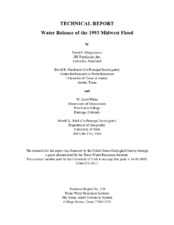| dc.description.abstract | Throughout the spring and summer months of 1993, extended rainfall throughout
much of the Midwestern United States caused record flooding that inundated much of the
Upper Mississippi River Basin (UMRB). Precipitation in May was more then twice the
normal over an area that extended from southeastern South Dakota across Iowa to eastern
Kansas. From early June to the end of July, high amounts of precipitation persisted over
the upper Midwest (Wahl, et al., 1993). USGS records indicated that at 45 streamflow
gauging stations, the peak discharge recorded during 1993 had recurrence intervals of
greater than 100 years. However, because of the natural and man-made changes in the
flood region, some sites had less-than-record peak discharges (Parret, et al., 1993). The
storage of large volumes of water in reservoirs significantly reduced the peak flow and
flood damages downstream from the dams (Southard, 1993).
Following the 1993 Midwest flood, President Clinton established the Scientific
Assessment and Strategy Team (SAST) on November 24, 1993, to study the effects of
the flood and to make recommendations about future flood preparedness. The SAST
joined the Interagency Floodplain Management Review Committee (FMRC) on January
10, 1994 (FMRC, 1994). As part of this effort, the SAST project identified a need for a
daily water balance of the flooded area to determine how much water fell and how quickly
it moved through the landscape.
There were two significant policy issues resulting from the flood: (1) how did the
flood volume and velocity of flow increase by land use changes associated with
agricultural development in the Midwest, including extensive drainage of wetlands; and (2)
what plan should be adopted for restoration of failed levee systems. The first of these
questions is hydrologic, the second, hydraulic. The hydraulic issues were addressed by
the SAST project and related efforts by modeling the motion of water through the main
tributaries of the Mississippi and Missouri Rivers where the major levee failures
occurred.
The hydrologic questions were not so readily addressed because of the huge region
affected by the flood, some 700,000 km2 in area. Flood hydrology models are normally
applied to regions 100 to 1,000 times smaller than this area. Thus, the need for the
present study arose – to model the movement of water through the landscape of the
SAST study area by constructing a daily water balance in a series of subwatersheds in the
flooded area.
A USGS WEB site designated for SAST is located at:
http://edcwww2.cr.usgs.gov/sast-home.html . Figure 1.1 shows the location and the extent
of the SAST study area. This region covers all of the UMRB above St. Louis and that
portion of the Missouri Basin whose drainage enters the Missouri River by watershed (Missouri, Platte, Kansas, Osage, and Gasconade Rivers). The contribution of the
remainder of the Missouri Basin was accounted for by using gauged data from tributary
flows at the border of the study region.
The goal of this project was to calculate the daily water balance for the SAST
region for 1993. A Geographic Information System (GIS) was used to determine the
balance. GIS offers a technology to formulate more objective and consistent methods to
synthesize collected data and to assess water quality and quantity over large areas
(Maidment, 1996). The spatial resolution of the SAST region was defined by the location
of discharge gauging stations as well as the completeness and quality of the discharge
record. The preliminary analysis was performed using daily discharge values recorded at
261 USGS stations from 01/01/1993 to 09/30/1993. The final water balance was
estimated for 132 watersheds defined by the stations that have a complete discharge
record for all days of 1993. The cumulative storage values were then spatially averaged
over 4, 6, and 8 digit hydrologic units (HUC) to provide an alternative way of viewing the
water balance.
Missouri River at
Yankton, SD
Platte River at
Luisville, NE
Kansas River at
Desoto, KS
Osage River near
St. Thomas, MO
Gasconade River near
Rich Fountain, MO
Mississippi River at
Inflow Thebes, IL
Outflow
Figure 1.1 Location and extent of the SAST region. | en |


